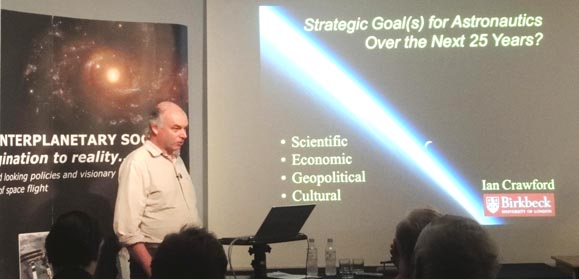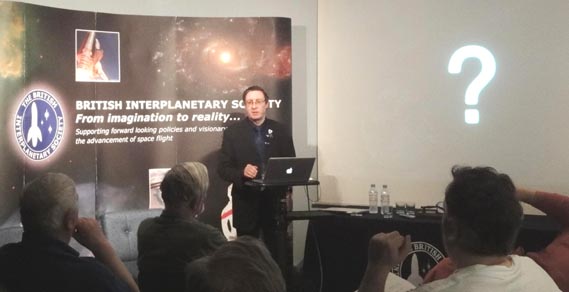= ASTRONAUTICAL EVOLUTION =
Issue 103, 1 July 2014 – 45th Apollo Anniversary Year
=============== AE ===============
The Great Space Debate – Discussion and Vote
Stephen Ashworth, Oxford, UK
What Should Be the Strategic Goal for Astronautics over the Next 25 Years?
Debate at the BIS, 1 May 2014
I have already posted the text of my own talk in the May issue of AE. There were two other main speakers. I shall summarise their talks here, and give at the bottom of the page the link to the full video recording of the event.
Professor Ian Crawford opened the evening with a scientist’s take on the question. But his view extended well beyond science alone to include economic, geopolitical and cultural aspects of “leaving the cradle” to create a spacefaring civilisation.

In his view, both robots and humans are needed to explore the Solar System. The added value of humans in planetary exploration scales with the geological complexity of the body, thus astronauts are more valuable on the Moon and Mars than on geologically simpler asteroids.
He is keen on using the water believed to exist at the lunar poles as the basis for a space economy. He pointed out that prospecting for resources for practical use has been a part of geology for a long time. But believes that lunar helium-3 is a red herring (with which I agree: we do not yet possess fusion reactors that can economically harness even the lower temperature deuterium-tritium reaction).
Ian emphasised the emergence in May 2007 of the International Space Exploration Coordination Group (ISECG) and its Global Exploration Roadmap (GER) as “the most positive development in space policy in recent years”. August 2013 was the second iteration of the Roadmap.
The Roadmap is ambivalent as between “Moon first” and “asteroid first” strategies for manned exploration. While both would be valuable, from a scientific point of view the Moon is the more attractive target. Any transport system which could reestablish astronauts on the Moon (and later Mars) would be scientifically valuable, whether based on using one big rocket or several smaller ones with orbital docking.
Concluding priorities were given as:
- Reduce the cost of access to space;
- Build international momentum behind ISECG and GER;
- Return to the Moon in the context of implementing GER;
- Leverage return to the Moon to build a functioning cislunar economy.
Ian recognised that reducing the cost of space access implies an increased role for commercial activities serving a broader market than today, but did not want to prioritise either commercial or government space over the other.
Jerry Stone is leader of the current BIS study project to update Gerard O’Neill’s space colony designs from the 1970s, as described in his classic book, The High Frontier.

In Jerry’s view, a number of different goals are being advocated for space, but there is no overall strategy. He proposed that the situation would be resolved by prioritising the overarching goal of the settlement of the inner Solar System with a permanent human presence in space. O’Neill’s plan for space colonisation would be the means to that end.
He focused on two key areas in which progress had to be made in order to fulfil that vision. One is the ecology of space colonies, in which people live permanently in a completely artificial habitat. This has not yet been achieved, yet is crucial if people are to live their entire lives off the mother planet.
The other is of course reducing the cost of access to space – a theme which appeared in the presentations from all three speakers.
Jerry concluded with a quote from Lord Martin Rees, the Astronomer Royal: “Once the threshold is crossed when there is a self-sustaining level of life in space, then life’s long-range future will be secure.”
Question time
In the following discussion, Duncan Law-Green argued that the current situation is so dynamic that it is impossible to forecast how it will evolve. How long will it take SpaceX to recycle one of their recoverable Falcon 9R rockets? What will they build after Falcon 9H? Any “strategic goal” is likely to be quickly overtaken by the dynamically evolving reality.

I defended the concept of the debate with the point that my option (5) (government exploration will get nowhere until commercial markets for space passenger transport are up to a level of say 1000/month) represents just such a diverse economy, in distinction to the traditional view that only government astronauts will be able to fly in space for the foreseeable future.
I emphasised how slow the process is, with still no private tourist flights to space ten years after the X Prize had been won, and still not a single person launched into orbit on a commercial vehicle.
This attracted criticism from Richard Osborne, who stated that SpaceX have as good as put people in orbit with their Dragon capsules, which certainly could have carried astronauts. Meanwhile the Google Lunar X Prize is likely to put private robots on the Moon in the next couple of years, with NASA actively encouraging private lunar exploration projects. Obviously, one may take either an optimistic or a more cautious view on these points.
In order to get some sort of meaningful vote at the end of the evening, I simplified the options down to two, thus whether or not a big bang in commercial access to space was about to happen. The majority of those present agreed that it was (I counted about 20 for the commercial big bang, and two or three against – one person I spoke to afterwards explained that he was ambivalent).
Final voting options
After further discussion, the final voting options addressing the question What should be the strategic goal for astronautics over the next 25 years? shaped up as follows:
- Building ISS on the Moon/Mars: An international government-led programme of astronaut exploration of Moon/Mars/asteroids as per the Global Exploration Strategy. (Commercial passenger spaceflight not expected to make major progress within this timeframe.)
- Fostering a commercial big bang: Consolidation of activities in low Earth orbit through government support for developing economically self-sustaining commercial passenger spaceflight, radically reducing the cost of access to orbit and increasing its frequency and reliability. (Astronaut exploration beyond LEO not expected to make major progress within this timeframe.)
- Building an O’Neill space settlement: An international programme in collaboration with energy companies for robotic and astronaut development of the Moon and near-Earth asteroids to set up a prototype space colony and satellite solar power station. (Major progress on this programme could be achieved within this timeframe, involving large numbers of people working in space.)
- Launching many more Curiosity/Hubble-type missions: Redirect public spending to increased robotic missions: surface rovers to seek for life within our Solar System, space telescopes to seek for Earth-analogue exoplanets. (Neither commercial passenger spaceflight nor astronaut exploration beyond LEO expected to make major progress within this timeframe.)
- All/none: none of options (1), (2), (3) or (4) any more strategically significant for the future of spaceflight than any other.
- Other: e-mail Stephen Ashworth to explain what.
Another way of looking at it is this: the point of discussing a strategic priority is to identify the blockage that has been acting as a brake on progress since the Challenger disaster, and how to remove it. Maybe I should have put the choices the other way around to highlight differing interpretations of where the problem lies:
(1) and (3): the blockage is the lack of government focus on a clear and inspiring goal – solution: give space agencies a clear, politically defined goal for their own astronaut exploration (Moon/Mars/asteroids/solar power satellites and space colonies).
(2): The blockage is the continuing paradigm of high costs to orbit – solution: develop competitive commercial markets, get traffic way up and ticket costs way down.
(4): The blockage is the fantasy that people can do anything useful in space – solution: keep people on the ground, send robots instead.
(5): There is no blockage – everything is proceeding as it ought, no particular solution necessary.
Obviously, once the obstruction to progress has been overcome then there will be no need to focus any further on one particular priority in space, as capabilities in all areas will then presumably grow naturally in parallel (unless another major blockage emerges further down the line – for example, an inability to solve the problem of living permanently in space, as Jerry Stone highlighted in his talk).
These voting options, together with a video of the evening, should be available soon on the BIS website, accessible to BIS members after logging in. The video by itself has now been posted on YouTube by DeltaVee media – thanks to Alan Marlow.